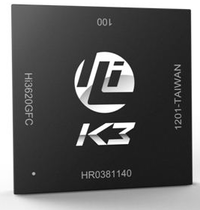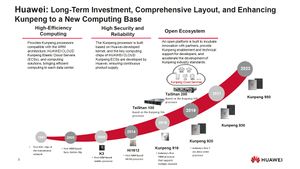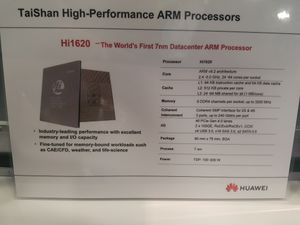From WikiChip
Difference between revisions of "hisilicon/k3"
(→Members) |
(fixed) |
||
| (2 intermediate revisions by one other user not shown) | |||
| Line 2: | Line 2: | ||
{{ic family | {{ic family | ||
| title = K3 | | title = K3 | ||
| − | | image = | + | | image = hi3620.png |
| caption = | | caption = | ||
| − | |||
| developer = HiSilicon | | developer = HiSilicon | ||
| developer 2 = ARM Holdings | | developer 2 = ARM Holdings | ||
| Line 16: | Line 15: | ||
| word = 32 bit | | word = 32 bit | ||
| proc = 0.18 µm | | proc = 0.18 µm | ||
| − | | proc 2 = | + | | proc 2 = 40 nm |
| tech = CMOS | | tech = CMOS | ||
| clock min = | | clock min = | ||
| Line 32: | Line 31: | ||
== Overview == | == Overview == | ||
| − | K3 was a family of high-performance mobile [[ARM]] [[system on chips]] designed by | + | [[File:kunpeng roadmap (2019).jpeg|left|thumb|Roadmap]] |
| + | [[File:hi1620 exhibit sign.jpg|left|thumb|TaiShan]] | ||
| + | K3 was a family of high-performance mobile [[ARM]] [[system on chips]] designed by [[HiSilicon]]. | ||
| − | + | Introduced in [[2008]], those chips were designed for high-performance [[smartphones]] and [[tablets]] primarily. Most of those chips were used heavily, although not exclusively, by [[Huawei]] own consumer electronics. K3 was [[HiSilicon]]'s first series to directly target the mobile performance market. In late [[2013]], [[HiSilicon]] replaced the K3 family by the {{\\|Kirin}} family and expanded their portfolio into mid-range performance models. | |
| − | + | {{clear}} | |
| − | + | == Models == | |
| − | |||
| − | |||
| − | |||
| − | |||
| − | |||
{{comp table start}} | {{comp table start}} | ||
<table class="comptable sortable tc4"> | <table class="comptable sortable tc4"> | ||
Latest revision as of 15:05, 27 March 2025
| K3 | |

| |
| Developer | HiSilicon, ARM Holdings |
| Manufacturer | TSMC |
| Type | Sysstem on chips |
| Introduction | 2008 (announced) |
| ISA | ARMv5 |
| µarch | ARM9 |
| Word size | 32 bit 4 octets
8 nibbles |
| Process | 0.18 µm 180 nm , 40 nm1.8e-4 mm 0.04 μm
4.0e-5 mm |
| Technology | CMOS |
| Succession | |
| → | |
| Kirin | |
K3 was a family of 32-bit ARM mobile SoCs introduced by HiSilicon since 2008.
Overview[edit]
K3 was a family of high-performance mobile ARM system on chips designed by HiSilicon.
Introduced in 2008, those chips were designed for high-performance smartphones and tablets primarily. Most of those chips were used heavily, although not exclusively, by Huawei own consumer electronics. K3 was HiSilicon's first series to directly target the mobile performance market. In late 2013, HiSilicon replaced the K3 family by the Kirin family and expanded their portfolio into mid-range performance models.
Models[edit]
| List of K3 Processors | |||||||||
|---|---|---|---|---|---|---|---|---|---|
| Main processor | Integrated Graphics | ||||||||
| Model | Launched | Transistors | Cores | Frequency | Cores | ISA | Designer | Name | Frequency |
| K3V1 | June 2008 | 200,000,000 | 1 | 0.46 GHz 460 MHz 460,000 kHz | ARM926EJ-S | ARMv5 | |||
| K3V2 | 26 February 2012 | 600,000,000 | 4 | 1.5 GHz 1,500 MHz 1,500,000 kHz | Cortex-A9 | ARMv7 | Vivante | GC4000 | 480 MHz 0.48 GHz 480,000 KHz |
| K3V2E | 2013 | 600,000,000 | 4 | 1.5 GHz 1,500 MHz 1,500,000 kHz | Cortex-A9 | ARMv7 | Vivante | GC4000 | 480 MHz 0.48 GHz 480,000 KHz |
| Count: 3 | |||||||||
See also[edit]
- MediaTek Helio
Facts about "K3 - HiSilicon"
| designer | HiSilicon + and ARM Holdings + |
| first announced | 2008 + |
| full page name | hisilicon/k3 + |
| instance of | integrated circuit family + |
| instruction set architecture | ARMv5 + |
| main designer | HiSilicon + |
| manufacturer | TSMC + |
| microarchitecture | ARM9 + |
| name | K3 + |
| process | 180 nm (0.18 μm, 1.8e-4 mm) + |
| technology | CMOS + |
| word size | 32 bit (4 octets, 8 nibbles) + |

